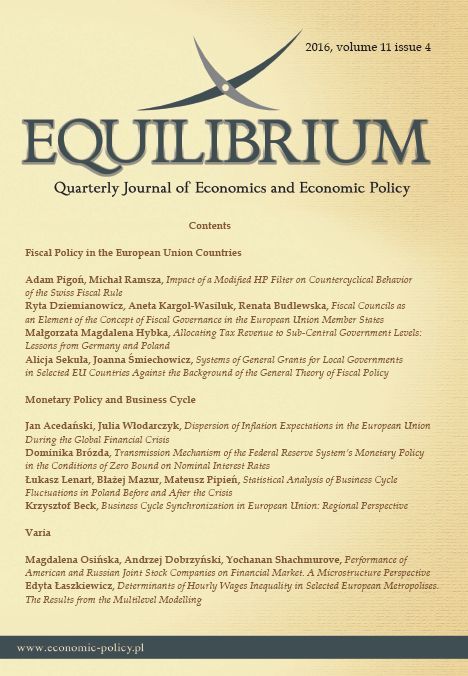Dispersion of inflation expectations in the European Union during the global financial crisis
DOI:
https://doi.org/10.12775/EQUIL.2016.033Keywords:
inflation expectations, survey data, global financial crisis, European UnionAbstract
Inflation expectations, both their median and dispersion, are of great importance to the effectiveness of monetary policy. The goal of this paper is to examine the impact of the global financial crisis on dispersion of inflation expectations in the European Union. Using European Commission?s survey data, we find that in the early phase of the crisis the dispersion dropped rapidly but then, after Lehman Brothers? collapse, the trend reversed and these fluctuations cannot be explained by movements of inflation rates and other commonly used factors. We also observe that, in the new European Union member states, the initial drop of the dispersion was weaker whereas the subsequent rise was stronger as compared to the old member states.
Downloads
References
Badarinza, C., & Buchmann, M. (2009). Inflation Perceptions and Expectations in the Euro Area ? the Role of News. ECB Working Paper, No. 1088.
Berk, J. M. (1999). Measuring Inflation Expectations: a Survey Data Approach. Applied Economics, 31(11). DOI: http://dx.doi.org/10.1080/000368499323337.
Berry, K. J., & Mielke, P. W., Jr. (1992). Assessment of Variation in Ordinal Data. Perceptual and Motor Skills, 74(1). DOI: http://dx.doi.org/10.2466/pms. 1992.74.1.63.
Capistrán, C., & Ramos-Francia, M. (2010). Does Inflation Targeting Affect the Dispersion of Inflation Expectation. Journal of Money, Credit and Banking, 42(1). DOI: http://dx.doi.org/10.1111/j.1538-4616.2009.00280.x.
European Commision (2015). Retrieved from http://ec.europa.eu/economy_finance /db_indicators/surveys/time_series/index_en.htm (20.02.2015).
Eurostat (2015). Retrieved from http://ec.europa.eu/eurostat (20.02.2015).
Galati, G., Poelhekke, S., & Zhou, C. (2011). Did the Crisis Affect Inflation Expectations? International Journal of Central Banking, 7(1).
Gerlach, P., Hördahl, P., & Moessner R. (2011). Inflation Expectations and the Great Recession. BIS Quarterly Review, March.
Gnan, E., Langthaler, J., & Valderrama, M. T. (2011). Heterogeneity in Euro Area Consumers? Inflation Expectations: Some Stylized Facts and Implications. Monetary Policy and the Economy, 2(11).
Lacy, M. G. (2006). An Explained Variation Measure for Ordinal Models with Comparison to Other Ordinal R2 Measures. Sociological Methods and Research, 34(4). DOI: http://dx.doi.org/10.1177/0049124106286329.
Leik, R. K. (1966). A Measure of Ordinal Consensus. Pacific Sociological Review, 9(2). DOI: http://dx.doi.org/10.2307/1388242.
Mankiw, N. G., Reis, R., & Wolfers, J. (2003). Disagreement about Inflation Expectations. NBER Macroeconomics Annual, 18. DOI: http://dx.doi.org/10.2139/ ssrn.417602.
Trehan, B., & Zorilla, O. (2012). The Financial Crisis and Inflation Expectations. FRBSF Economic Letter, 29.






